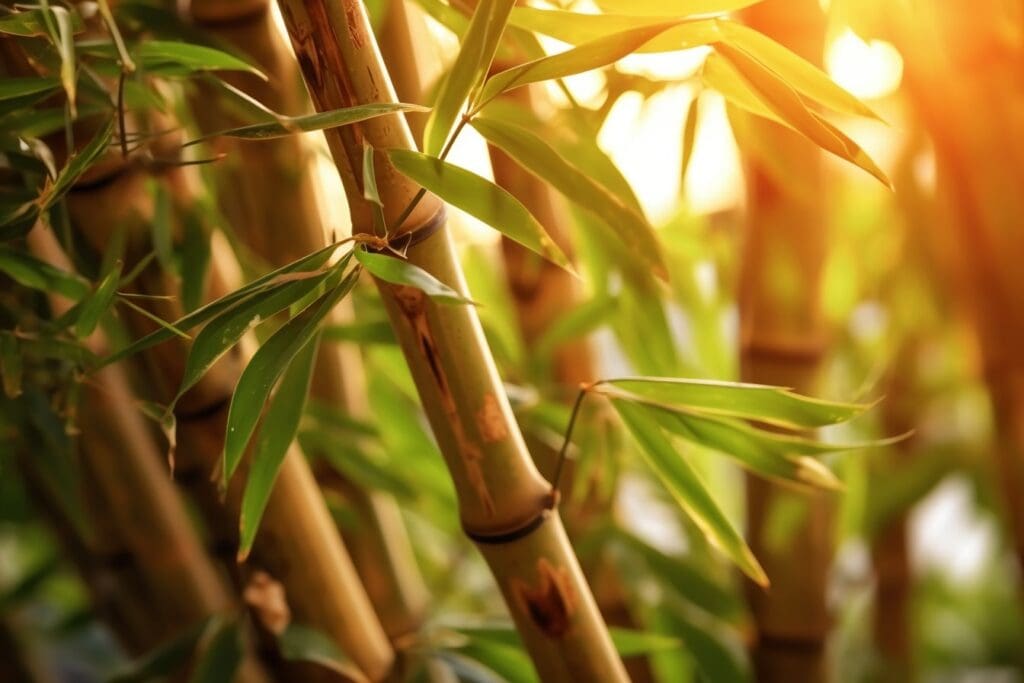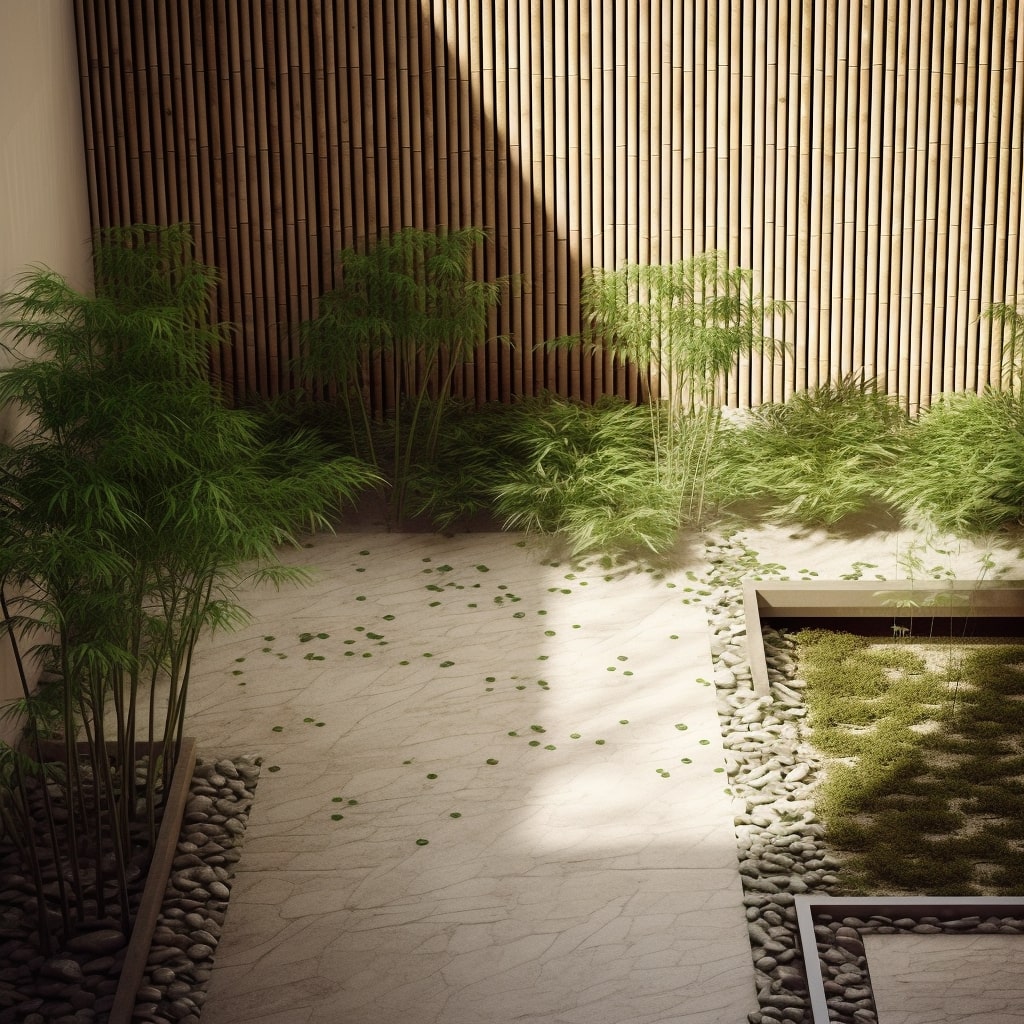Bamboo has the potential to thrive in the challenging desert conditions of Arizona. While the hot and dry climate presents certain obstacles, with the right care and selection of appropriate bamboo species, successful cultivation is possible.
Proper soil manipulation, regular watering, and partial shade are essential for the successful growth of bamboo in the desert. The benefits of growing bamboo in Arizona are numerous, including erosion control, carbon dioxide absorption, natural shade and cooling, as well as its ornamental beauty.
Key Takeaways
-
Bamboo can be successfully grown in Arizona with the right species selection and proper care.
-
Selecting clumping varieties of bamboo, such as Alphonse Karr and Weaver’s bamboo, is recommended to avoid invasive spreading.
-
Consistent watering, especially during the first few years, is crucial for bamboo growth in the desert.
-
Creating a suitable microclimate, providing partial shade, and using soil amendments can help overcome the challenges of growing bamboo in the desert.
Can Bamboo Survive Desert Conditions?
Planting bamboo in the desert can be challenging due to the hot and dry climate. However, with proper care and the selection of suitable species, it is possible to cultivate bamboo successfully.
One important aspect to consider is bamboo watering techniques. In the desert, bamboo requires consistent moisture, especially during the first three to four years of growth. Watering every other day is recommended, but it is crucial to ensure that the soil does not remain wet or soggy.

Additionally, providing partial shade can be beneficial for bamboo growth in the desert. Another consideration is controlling bamboo growth, as some varieties can quickly spread and become invasive. Choosing clumping bamboo species, such as Alphonse Karr and Weaver’s bamboo, can help prevent unwanted expansion and maintain control in the desert landscape.
Best Bamboo Species for Arizona
The selection of suitable bamboo species for cultivation in the arid climate of Arizona is crucial for successful growth and management. When considering bamboo for desert landscaping in Arizona, it is important to choose drought-tolerant varieties that can withstand the hot and dry conditions.
Here are some key factors to consider for bamboo care in Arizona:
-
Drought-tolerant varieties: Select bamboo species that are known to thrive in desert conditions, such as Alphonse Karr and Weaver’s bamboo, which are clumping types that are less likely to spread and become invasive.
-
Adequate watering: Although bamboo requires consistent moisture, it is important to avoid overwatering. Watering every other day is recommended for bamboo in the desert, ensuring that the soil does not remain wet or soggy.
-
Soil amendments and mulch: Adding organic matter to the soil and applying mulch can help bamboo roots hold water and improve overall soil moisture retention.
-
Partial shade: Providing partial shade can be beneficial for bamboo growth in the desert, as it helps to reduce stress from direct sunlight and extreme temperatures.
-
Proper maintenance: Regular inspections, pruning, and controlling runners are essential for managing bamboo growth and preventing it from becoming a nuisance in the desert landscape.
By considering these factors and choosing the right bamboo variety, it is possible to successfully grow and maintain bamboo in the arid climate of Arizona.
Challenges of Growing Bamboo in Arizona
One of the main challenges faced when attempting to cultivate bamboo in the arid climate of Arizona is the scarcity of water resources. Bamboo is a plant that requires consistent moisture, especially during its initial growth period. The desert environment of Arizona poses a significant obstacle in providing the necessary water for bamboo to thrive.



Bamboo has specific temperature requirements, and the extreme heat of the desert can be detrimental to its growth. However, there are ways to overcome these challenges. Locating microclimates within the desert can provide some relief from the harsh conditions, as these areas may offer slightly higher humidity levels and lower temperatures.
Selecting bamboo species with higher drought tolerance can increase the chances of successful growth in the arid climate of Arizona.
Watering and Soil Requirements
Watering and soil requirements play a crucial role in the successful cultivation of bamboo in the desert. Due to the arid climate, providing adequate water is essential for the initial establishment and growth of bamboo plants.
For the first three to four years, bamboo in the desert requires lots of water, and a watering schedule of every other day is recommended. However, it is important to ensure that the soil does not remain wet or soggy, as this can lead to root rot.
Soil amendments and mulching techniques can help the bamboo roots retain moisture. Additionally, creating microclimates by providing partial shade can be beneficial for bamboo growth in the desert. By carefully managing the watering and soil conditions, bamboo can thrive in the desert landscape of Arizona.
Managing Spread and Invasiveness
When growingn any bamboo, it is wise to manage its spread and prevent invasiveness. One of the main concerns with bamboo is its ability to produce ‘runners’, which can quickly spread and become invasive in the desert environment. Controlling runners is essential to maintain the desired size and prevent bamboo from encroaching on neighboring areas.
The first step to doing so is selecting clumping bamboo varieties, such as Alphonse Karr or Weaver’s bamboo, as clumping bamboos tend to stay more contained.
Alternatively, this can be achieved by installing a physical barrier, such as a root barrier, to prevent the underground rhizomes from spreading. Regular monitoring and pruning of the bamboo can also help manage its growth and prevent it from becoming unruly.
Benefits of Growing Bamboo in Arizona
One of the advantages of cultivating bamboo in the arid climate of Arizona is its ability to stabilize soil and reduce erosion, making it a valuable asset in areas prone to soil degradation. Bamboo’s extensive root system helps bind the soil together, preventing erosion and protecting against the negative impacts of wind and water.
This can be particularly beneficial in Arizona, where soil erosion is a common problem due to the dry and often windy conditions. Additionally, bamboo’s fast growth rate and dense foliage can provide shade and cooling, reducing the need for air conditioning and contributing to water conservation efforts.
Furthermore, bamboo’s ornamental beauty adds to the landscape aesthetics, enhancing the overall environmental sustainability of the area.
Choosing the Right Bamboo Variety
Selecting the appropriate bamboo variety for the desert landscape is crucial to ensure successful growth and mitigate the risk of invasive spread and uncontrolled growth. When choosing a bamboo variety for Arizona, there are several factors to consider, including the plant’s adaptability to the arid climate, its growth habit, and its maintenance requirements.



Here are three key considerations to keep in mind:
-
Drought-tolerant species: Opt for bamboo varieties that are known for their ability to withstand hot and dry conditions. Species like Alphonse Karr and Weaver’s bamboo are well-suited for desert environments.
-
Clumping vs. running bamboo: Clumping bamboo varieties, such as Alphonse Karr and Weaver’s bamboo, are preferable for desert growth as they are less likely to spread uncontrollably and become invasive.
-
Maintenance requirements: Consider the amount of maintenance and care the bamboo variety requires. Some varieties may need regular pruning to control their growth, while others may be more low-maintenance.
By carefully selecting the right bamboo variety that thrives in the desert climate and meets your maintenance preferences, you can enjoy the beauty and benefits of bamboo without the risk of invasive spread or excessive maintenance.
Frequently Asked Questions
Q: Does Bamboo Grow in Arizona?
A: Yes, bamboo can grow in Arizona.
Q: Can bamboo grow in the desert?
A: Yes, some species of bamboo can grow well in desert conditions.
Q: Is it possible to grow bamboo in Arizona?
A: Yes, it is possible to grow bamboo in Arizona.
Q: Which species of bamboo grow well in Arizona?
A: Some popular species of bamboo that grow well in Arizona include timber bamboo, Mexican weeping bamboo, and running bamboo.
Q: Where can I find a bamboo ranch in Tucson?
A: There is a bamboo ranch in Tucson known as the Bamboo Ranch, specializing in growing a variety of bamboo species.
Q: How do I plant bamboo in Arizona?
A: To plant bamboo in Arizona, you should dig a hole that is the same depth as the root ball and slightly wider. Place the bamboo plant in the hole, backfill with soil, and water thoroughly.
Q: How much water does bamboo need in Arizona?
A: Bamboo in Arizona typically requires a modest amount of water. Watering every day or every other day should be sufficient, depending on the specific species and environmental conditions.
Q: How fast does bamboo grow in Arizona?
A: Bamboo is known for its fast-growing nature, which means it only takes a few years for the plant to reach its full height in Arizona.
Q: Does bamboo grow well in lawns?
A: Yes, bamboo can grow well in lawns as long as it receives adequate water and sunlight.
Q: What are the characteristics of Mexican weeping bamboo?
A: Mexican weeping bamboo is also known for its delicate foliage and slender culms. It grows in dense clumps and adds an elegant touch to any garden.
Conclusion
In conclusion, while growing bamboo in the desert climate of Arizona may present some challenges, it is indeed possible with the right species selection and proper care.
Clumping varieties like Alphonse Karr and Weaver’s bamboo are more suitable as they are less likely to become invasive.
Consistent moisture, partial shade, and soil manipulation are essential for successful cultivation.
Despite the challenges, growing bamboo in Arizona offers numerous benefits such as erosion control, carbon dioxide absorption, natural shade and cooling, and ornamental beauty.

